Top 5 NodeJS Frameworks in 2024
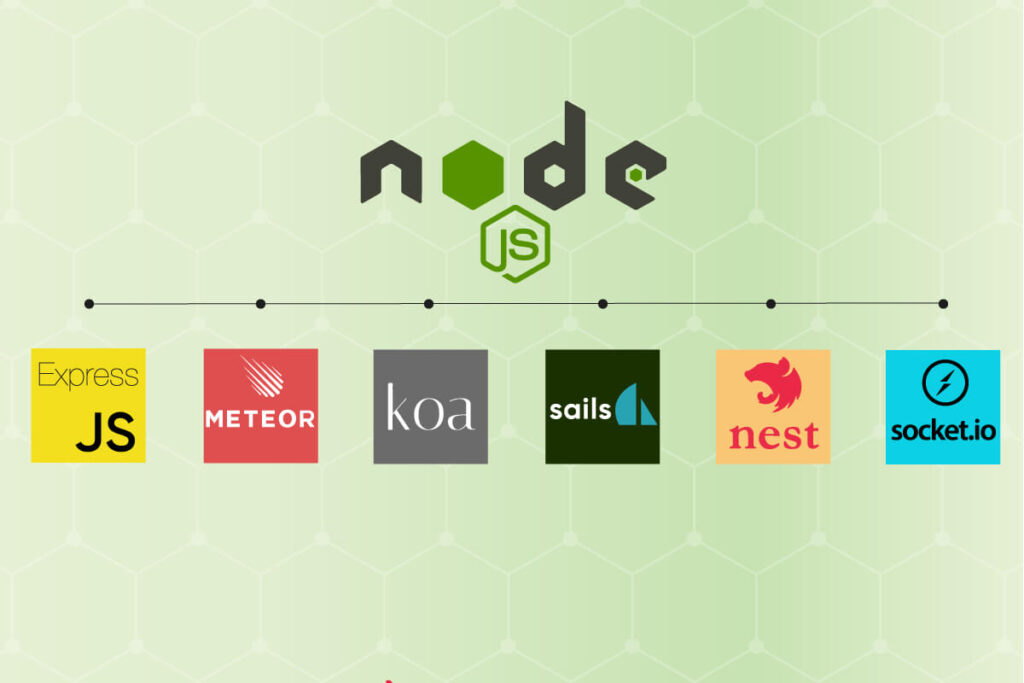
As the server-side platform is built on Google Chrome’s V8 JavaScript Engine, Nodejs is open-source. Node.js applications for mobile devices are part of the broader appeal within the developer community. Node.js provides the runtime environment. In today’s business landscape, companies consider web applications as necessary. In the past, Node.js frameworks became increasingly popular. The development process can be simplified through powerful tools, allowing for the easy creation of apps and websites. Quickly, a helpful structure helps build remarkable web applications.
This blog focuses on enterprise node js frameworks for 2024. Let us explore the features, pros, and uses of different Node js frameworks. Each of these technologies has its own unique set of frameworks. The development lifecycle assigns use cases according to a specific framework.
What are Node.js Frameworks?
Developers build frameworks for Node.js on top of the runtime environment. Web applications can be quickly and efficiently built with Node.js frameworks, utilizing pre-defined tools and libraries.
Node JS frameworks streamline development activities. With Node.js, software developers can focus more on the central logic of Node.js apps.
Node.js frameworks are broadly categorized into three types:
- MVC frameworks
- Full-stack MVC frameworks
- REST API frameworks
MVC Frameworks
MVC, or Model-View-Controller, is a design pattern. (In software engineering, a software design pattern is a general, reusable solution to a commonly occurring problem within a given context in software design. It is not a finished design that can be transformed directly into source code or machine code) which is used to create the frameworks that separate the Node.js application logic into three interconnected components: models, views, and controllers.
Maintaining and scaling Node.js applications becomes easier when individual components are kept separate, as this separation permits developers to work independently of the entire program architecture.
Full-Stack MVC Frameworks
An integrated approach for creating complete web applications, from the front end to the back end, is provided by full-stack MVC. One can develop innovative and time-sensitive web apps with fewer efforts by leveraging available resources.
REST API Frameworks
REST API frameworks emulate the REST architectural design to build APIs. Uninterrupted communication between clients and servers is facilitated by the easy and efficient creation of web and mobile Node.js app APIs.
Top NodeJS Frameworks
Express.js
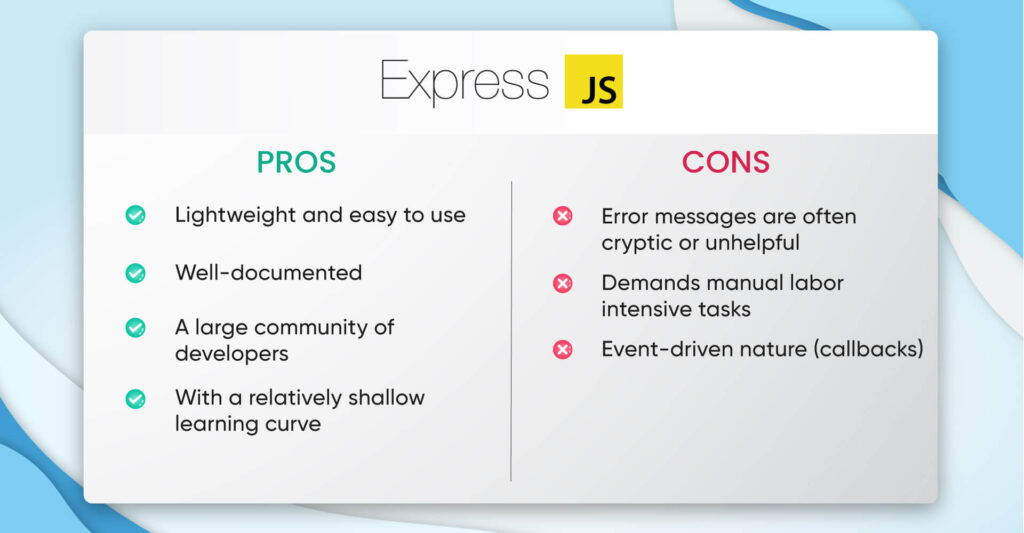
One of the best and most popular Node.js frameworks, Express.js is. Lightweight and adaptable, this framework makes web application development easy.
A well-documented framework, Express.js attracts a thriving community of skilled devs. With simple architecture, how can we capitalize on high-speed operations?
Developers require few development skills when developing anything from scratch. What Express enables us to do is the directing of servers and routes. Help is provided in designing web applications that rely on template passing.
With Express, we can generate HTML pages dynamically. An MVC-like structure facilitates high-speed input-output operations with ExpressJS. The possibility of easy routing arises due to these things.
Pros of Express.js:
- Lightweight and easy to use
- Well-documented
- A large community of developers
- Creating web apps is simple and quick for developers nowadays.
- With a relatively shallow learning curve.
Cons of Express.js:
- Some other frameworks have more features compared to this one
- Error messages are typically unhelpful or challenging to decipher.
- Event-driven nature (callbacks)
Meteor.js
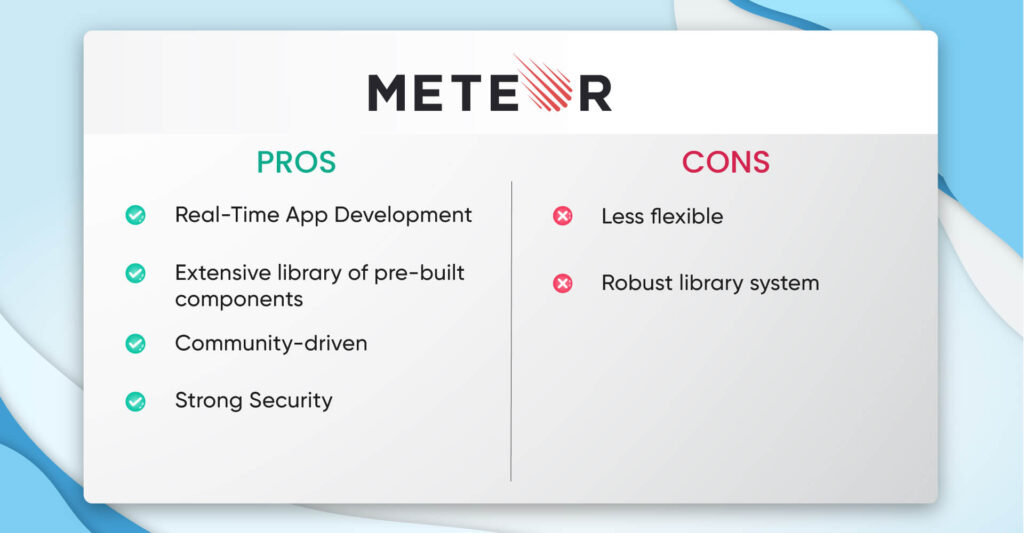
Thanks to Meteor’s full-stack capabilities one can develop real-time web and mobile applications quickly. Node.js and MongoDB are the engines behind Meteor.js’ successful employment of a publishing-subscribing mechanism. Efficient and engaging applications can be built with this capability by developers.
Pros of using Meteor.js:
- Real-time application building, by default, is accessible with Meteor. With an API, Meteor offers publishing and subscription features. Developers can publish the data Data from the server’s database by using that. Within the client, they can subscribe and receive real-time updates when changes occur to the data.
- Extensive library of pre-built components.
- Developers actively contribute to the community and support Meteor. Despite becoming commercial through Meteor Cloud, an open-source project, Meteor still maintains.
- With various safety features such as encryption, HTML escaping, secure browser storage, and others, Meteor offers robust protection.
Cons of using Meteor.js:
- Meteor.js presents a steep learning curve, especially for beginners in web development, due to its unique tools and conventions.
- Its monolithic architecture combines frontend and backend development, limiting flexibility for complex projects or microservices.
- The framework’s reliance on its backend technology (DDP) can restrict backend and database choices.
- Meteor has a smaller ecosystem and community compared to other JavaScript frameworks.
- Scalability can be challenging, requiring custom solutions for high-traffic applications.
- Package management can lead to versioning conflicts and may only sometimes offer the latest packages.
- While Meteor excels in real-time capabilities, its overall performance may differ from other options.
Koa.js
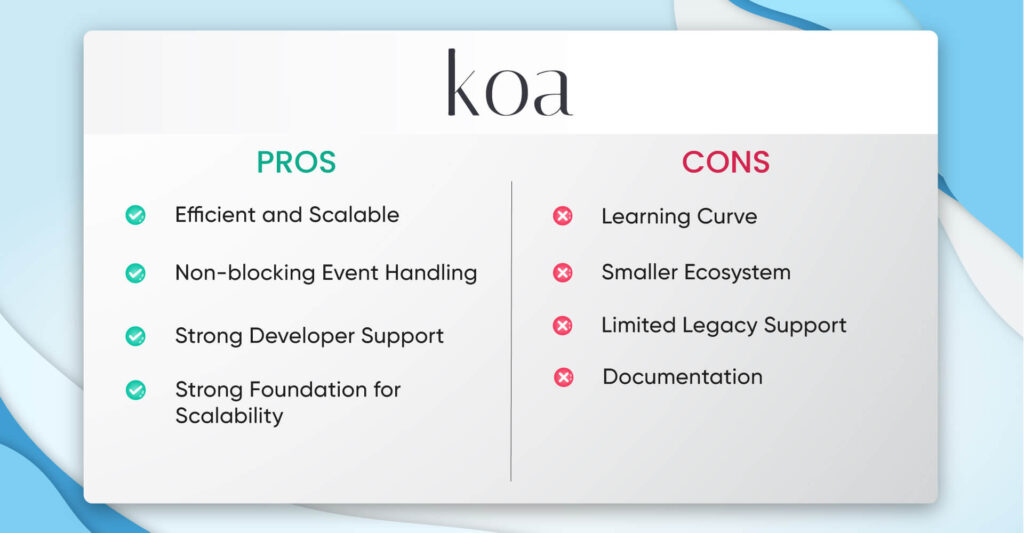
A newer Node.js framework has been developed, which is more efficient and scalable than Express.js. Requests are handled more efficiently by Koa.js, which features an event loop that doesn’t block.
Koa improves error handling by using async functions, which eliminate callbacks. Server creation is expedited, and entertainment is guaranteed by Koa, which has no middleware.
Pros of Koa.js:
- Due to Koa having more features, it’s much more efficient and scalable than Express.
- Koa handles event loops without blocking. Optimizing app performance through continuous execution is made possible by finishing one process before moving on to another, and this is considered a key feature.
- Substantial support for Koa exists due to the enthusiastic involvement of software builders in this area.
Cons of Koa.js:
- Express.js should be well-documented. Although Koa requires additional documentation, it benefits from good community support.
- Learning can be challenging for rookies. If you are new to Node.js frameworks, attempting to learn them is not advisable.
Sails.js
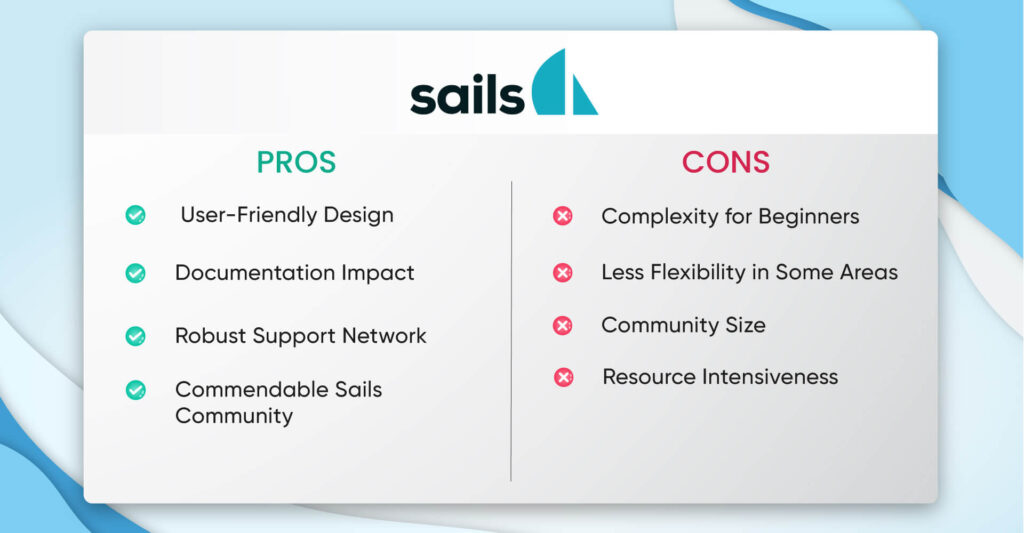
Sails.js (or Sails)is a Node. The Node.js MVC framework was created within the Node.js ecosystem and is open source under the MIT License.
This tool enables the creation of tailored, high-end Node.js web apps and APIs.
Developers encounter less resistance with Sails because it adopts Node.js. It is a Node.js MVC framework akin to Ruby on Rails and others.
Pros of using Sails.js:
- Our MVC framework is designed to be extremely easy to use.
- If appropriately documented, its use will be simple. New framework users must follow the documentation in order to solve most problems
- Something offered by the Sails community is good documentation for developers.
- Thanks to the extensive network available within this field developers can resole any obstacle that they face. So overall, it’s a good choice as well.
Cons of using Sails.js:
- This framework has more features than other ones. Sails require specific elements to make it more efficient than it currently is.
- Beginners should refrain from learning this framework because it is too difficult.
Nest.js
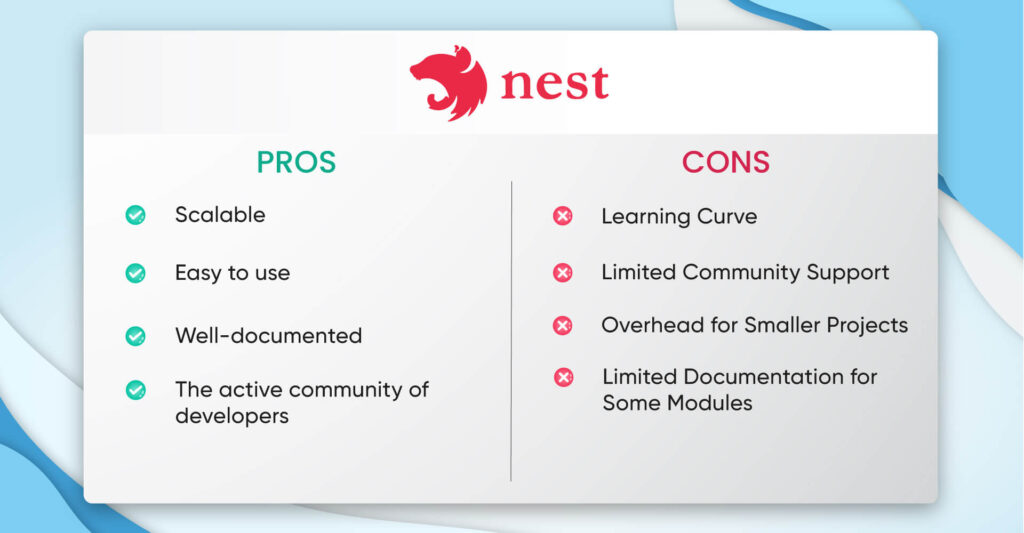
NestJS offers an efficient and scalable Node.js server development framework. Nest uses progressive JavaScript, and it is constructed with TypeScript, supporting TypeScript while enabling coding in pure JavaScript. Nest.js allows for object-oriented programming, functional programming, and functional reactive programming.
Nest.js internally supports both Express and Fastify as HTTP server platforms. Exposure of APIs by Nest sits beneath Express and Fastify frameworks, providing higher levels of abstraction. With this feature, third-party modules can be used within the platform. With TypeScript, Nest.js apps are built. Compile time sees error detection take place. While building microservices, Nest.js helps devs avoid errors caused by duplicate responses.
Pros of using Nest.js:
- Scalable
- Easy to use
- Well-documented
- The active community of developers
Cons of using Nest.js:
- Other frameworks may have more recognition compared to this one.
- Learning can be difficult for novice individuals.
Socket IO
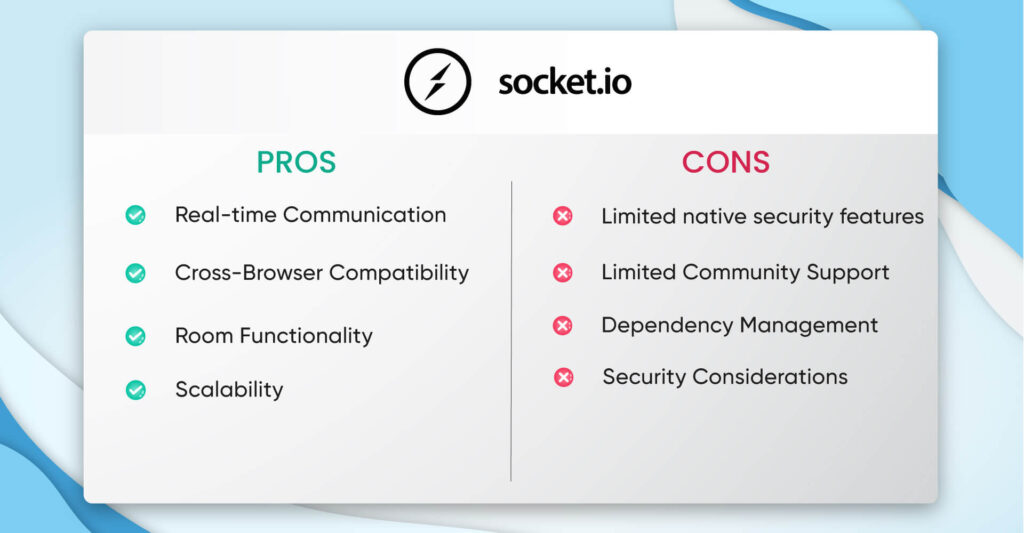
Developers use Socket.IO, a JavaScript library, to develop real-time web applications. Real-time and bi-directional communication has become possible due to this technology. A client-side library runs in browsers, and a server-side library serves node.js. Identical APIs belong to both components.
Pros of Socket IO:
- It supports multiplexing through namespaces. By implementing namespaces, you can minimize the number of TCP connections required and free up socket ports on the server.
- It allows the server side to broadcast events to all connected clients flexibly. You can also broadcast events to a subset of clients viagivingooms a feature.
Cons of Socket IO:
- Socket guarantees messaging semantics, specifically once and exactly. IO. An at-most-once guarantee is provided by default. Configuration can offer at least one guaranteed message. This new challenge requires solving through estimation, timeouts, distinct identification, and database event recording.
- Socket.IO comes with limited native security features. An Express. jsion token generation and renewal functionality are also missing, making another example.
Choosing the Right Node.Js Framework for Your Project
Essential for developing web apps/services in JavaScript, frameworks in Node.js prove their value as essential tools. Develop simplicity, speed, and scalability through top Node.js frameworks. The framework ensures consistency and maintenance.
1. Express.js: Express.js is a framework for developing web and web services. It is easy to use and designed for speed.
2. Koa.js: Koa.js is a lightweight and modern framework. The same team creates it similarly to Express.js. This framework offers versatile solutions and is fundamental to website and app development.
3. Nest.js: Type compatibility via TypeScript is provided by Nest.js, like other Node.js frameworks. Web design primarily focuses on creating well-organized and large-scale sites with its help. This framework can handle multiple users simultaneously. Developers can make changes without getting messy.
4. Adonis.js: Adonis.js enables full-stack web development. It follows the MVC pattern, making things easier for developers to manage. Comprehensive functionality is provided via this platform thanks to its inclusion of ORM, authentication, plus other features.
5. Meteor.js: Developers consider the JavaScript framework Meteor as a full-stack solution. They use this framework to make websites that show real-time updates, like chat apps.
Frequently Asked Questions
Which Node.js framework will work best depends on multiple factors such as project scope, necessary features, and team expertise.
A small project requires Express JS with an inexperienced group. Framework flexibility, scalable performance, and efficiency highlight Node.js as a lightweight web app solution. Fast, powerful, and flexible, MVC models give us.
Developers use NestJS for more significant ventures. TypeScript is employed when creating Nest.js apps, with error detection occurring during code compilation. Nest.js prevents errors resulting from similar responses while multiple microservices are being written. Developers aid themselves by building organized, lightweight, and distinct services. NestJS supports both Monoliths and microservices.
The best node.js frameworks are as follows:-
- Express.js
- Nest.js
- Meteor.js
- Koa.js
Available and renowned, Express.js is among the popular Node.js frameworks. Lightweight but powerful, this framework makes web app dev easy and flexible. Documentation for Express.js is excellent, and so is the size of its developer community. With Express, the simplification of directing servers and routes occurs. Express facilitates the more accessible designing of multiple web applications using templates. Express assists with Dynamic Rendering via HTML pages. Thanks to Express.js’ fast input/output operations, singular thread character, MVC architecture resemblance, and extensive library, developers can easily handle routing. It is robust.
A platform for running JavaScript code without restrictions is Node.js, an open-source environment. Neither a framework nor a programming language, NodeJS must be remembered. Node JS framework needs explanation and comprehension from most people. Typically, developers use Node.js when creating backend systems, including APIs like Web App or Mobile App These companies include PayPal, Uber, Netflix, Walmart, and LinkedIn; they use it in production.




